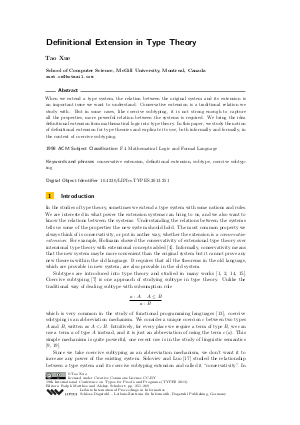Definitional Extension in Type Theory
Author Tao Xue
-
Part of:
Volume:
19th International Conference on Types for Proofs and Programs (TYPES 2013)
Part of: Series: Leibniz International Proceedings in Informatics (LIPIcs)
Part of: Conference: International Conference on Types for Proofs and Programs (TYPES) - License:
 Creative Commons Attribution 3.0 Unported license
Creative Commons Attribution 3.0 Unported license
- Publication Date: 2014-07-25
File

PDF
LIPIcs.TYPES.2013.251.pdf
- Filesize: 0.53 MB
- 19 pages
Document Identifiers
Subject Classification
Keywords
- conservative extension
- definitional extension
- subtype
- coercive subtyping
Metrics
- Access Statistics
-
Total Accesses (updated on a weekly basis)
0Document
0Metadata
Abstract
When we extend a type system, the relation between the original system and its extension is an important issue we want to know. Conservative extension is a traditional relation we study with. But in some cases, like coercive subtyping, it is not strong enough to capture all the properties, more powerful relation between the systems is required. We bring the idea definitional extension from mathematical logic into type theory. In this paper, we study the notion of definitional extension for type theories and explicate its use, both informally and formally, in the context of coercive subtyping.
Cite As Get BibTex
Tao Xue. Definitional Extension in Type Theory. In 19th International Conference on Types for Proofs and Programs (TYPES 2013). Leibniz International Proceedings in Informatics (LIPIcs), Volume 26, pp. 251-269, Schloss Dagstuhl – Leibniz-Zentrum für Informatik (2014)
https://doi.org/10.4230/LIPIcs.TYPES.2013.251
BibTex
@InProceedings{xue:LIPIcs.TYPES.2013.251,
author = {Xue, Tao},
title = {{Definitional Extension in Type Theory}},
booktitle = {19th International Conference on Types for Proofs and Programs (TYPES 2013)},
pages = {251--269},
series = {Leibniz International Proceedings in Informatics (LIPIcs)},
ISBN = {978-3-939897-72-9},
ISSN = {1868-8969},
year = {2014},
volume = {26},
editor = {Matthes, Ralph and Schubert, Aleksy},
publisher = {Schloss Dagstuhl -- Leibniz-Zentrum f{\"u}r Informatik},
address = {Dagstuhl, Germany},
URL = {https://drops.dagstuhl.de/entities/document/10.4230/LIPIcs.TYPES.2013.251},
URN = {urn:nbn:de:0030-drops-46352},
doi = {10.4230/LIPIcs.TYPES.2013.251},
annote = {Keywords: conservative extension, definitional extension, subtype, coercive subtyping}
}
Author Details
References
-
David Aspinall and Adriana Compagnoni. Subtyping dependent types. Theoretical Computer Science, 266(1-2):273-309, 2001.

-
Gilles Barthe and Maria João Frade. Constructor subtyping. In S. Doaitse Swierstra, editor, Proceedings of Programming Languages and Systems, 8 conf. (ESOP'99), volume 1576 of Lecture Notes in Computer Science, pages 109-127. Springer, 1999.

-
Robert Harper, Furio Honsell, and Gordon D. Plotkin. A framework for defining logics. In Proceedings of Symposium on Logic in Computer Science 1987, pages 194-204. IEEE Computer Society, 1987.

-
Martin Hofmann. Extensional Concepts in Intensional Type Theory. PhD thesis, University of Edinburgh, 1995.

-
Stephen Kleene. Introduction to Metamathematics. North Holland, 1952.

-
Zhaohui Luo. Computation and Reasoning: A Type Theory for Computer Science. Oxford University Press, 1994.

-
Zhaohui Luo. Coercive subtyping. Journal of Logic and Computation, 9(1):105-130, 1999.

-
Zhaohui Luo. D-conservativity. Notes, January 2012.

-
Zhaohui Luo. Formal semantics in modern type theories with coercive subtyping. Linguistics and Philosophye, 35(6):491-513, 2012.

-
Zhaohui Luo and Robert Pollack. Lego proof development system: User manual, 1992.

-
Zhaohui Luo, Sergei Soloviev, and Tao Xue. Coercive subtyping: Theory and implementation. Information and Computation, 223:18-42, February 2013.

-
Per Martin-Löf. Intuitionistic Type Theory. Bibliopolis, 1984.

-
Robin Milner. A theory of type polymorphism in programming. Journal of Computer Systems and Sciences, 17:348-375, 1978.

-
John C. Mitchell. Type inference with simple subtypes. Journal of Functional Programming, 1(3):245-285, 1991.

-
Bengt Nordström, Kent Petersson, and Jan M. Smith. Programming in Martin-Löf’s Type Theory: An Introduction. Oxford University Press, Oxford, 1990.

-
Robert Pollack. Implicit syntax. In the preliminary Proceedings of the 1st Workshop on Logical Frameworks, 1990.

-
Sergei Soloviev and Zhaohui Luo. Coercion completion and conservativity in coercive subtyping. Annals of Pure and Applied Logic, 113(1-3):297-322, 2002.

-
Tao Xue. Theory and Implementation of Coercive Subtyping. PhD thesis, Royal Holloway, University of London, 2013.

-
Tao Xue and Zhaohui Luo. Dot-types and their implementaion. Logical Aspects of Computational Linguistics (LACL'12). LNCS, 7351:234-249, 2012.

